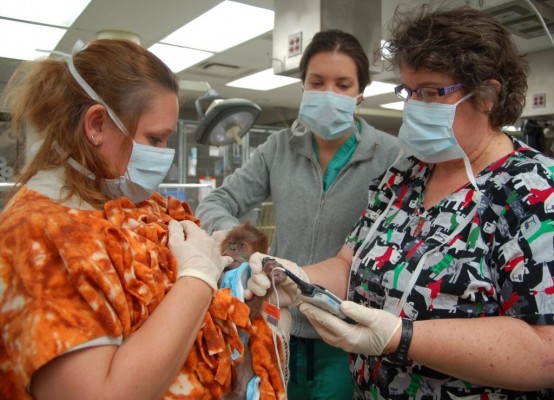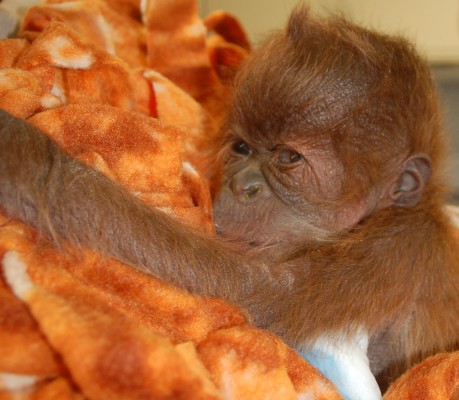This is Markisa’s second required C-section, both of which were performed at the Veterinary Medical Center. “C-sections are very rare in that there are only about a dozen recorded within the International Orangutan Studbook that has tracked more than 1,200 births in captivity throughout history” said Como Zoo primate keeper Megan Elder, who also serves as the International Studbook Keeper for the World Association of Zoos & Aquariums (WAZA) and the Vice-Chair for the North America Orangutan SSP.
This is a very important birth both for Como and for the species. Markisa was recommended for breeding by the Association of Zoos and Aquariums (AZA) Orangutan Species Survival Plan (SSP) because of her status as one of the most genetically valuable female Sumatran orangutans in North America.
The delivery was attended by an assemblage of experts in human maternal health and consultant veterinarians from the University of Minnesota Veterinary Medical Center and the University of Minnesota Fairview Medical Center. Many of these individuals have been prepping for weeks for this procedure and several (Yasuko Yamamura, MD and Kirk Ramin, MD) consulted on Markisa’s last C-section. These included an obstetrical team of 14-16 individuals including professionals from the human and animal neonatal intensive care units, human maternal-fetal medicine, veterinary surgeons, veterinary technicians, veterinary anesthesiologists, a nutritionist, and a biosecurity supervisor.
Markisa is back at Como Zoo and recovering from the procedure. Her infant is currently in an ICU unit at the University of Minnesota Veterinary Medical Center in the care of Como Zoo primate keeper professionals. She is expected to return to Como Zoo within a day or two. The newborn female is being bottle-fed by Como staff during the time she is separated from Markisa.
Como Zoo plans to visually reintroduce the infant and her mother upon the infant’s return to Como. The reintroduction process may take several days to weeks.
The Association of Zoos and Aquariums governs a Species Survival Plan (SSP) for endangered species in captivity in the United States. The committee that supervises the SSP for orangutans set guidelines and recommendations each year to manage the captive population. “The SSP provides good zoo homes for each animal and helps to maintain a diverse gene pool with in the zoo community” explains Como Campus Manager Michelle Furrer. “The Zoo will work with the SSP to ensure that this animal becomes a healthy addition to the zoo population.”
About 200 orangutans are currently on exhibit in zoos throughout the U.S. Their native population, found primarily in Sumatra and Borneo, has dwindled due to commercial logging, agriculture, hunting and poaching –all of which put the species under the threat of extinction.
Sponsor the baby Orangutan! Sponsoring an animal makes a great gift – that keeps giving back. Animal sponsorships are a unique way to help Como Park Zoo and Conservatory with its wildlife conservation efforts. They support enhanced habitats and efforts to maintain the best care possible for the animals at Como Zoo. To purchase, visit Garden Safari Gifts at Como Park Zoo and Conservatory or call 651-487-8229.


No comments:
Post a Comment